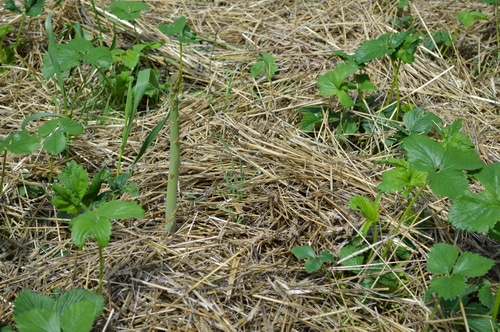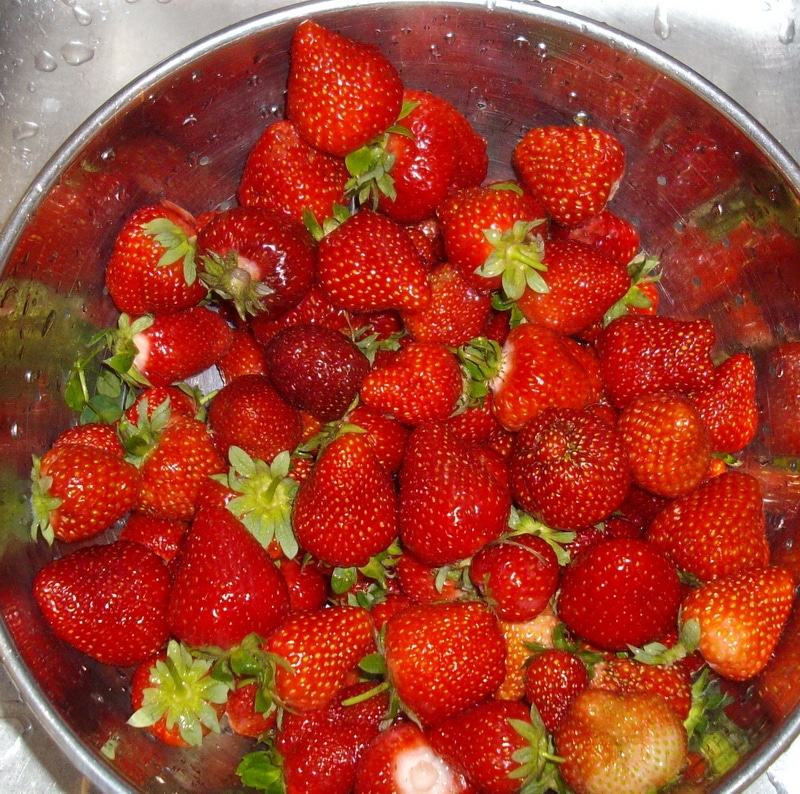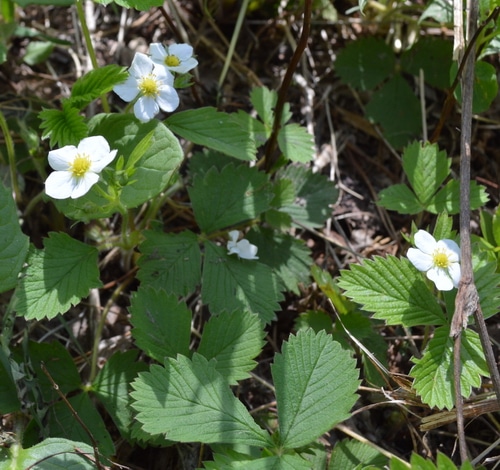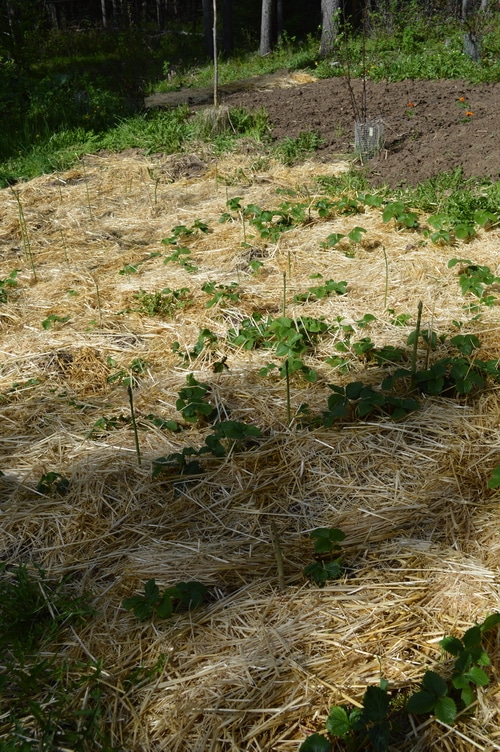How to grow strawberries and asparagus in the same bed and double your yields without chemicals. A well-managed perennial bed will continue to produce for 20 or even 30 years. The sooner you plant them, the sooner you’ll realize a harvest. Here’s what you need to know to get the most from these easy to grow perennials.
Strawberries and asparagus are natural companions. Both are early spring crops that will begin to produce after your last frost date. They root on different levels to maximize the nutrient return in your garden. Both should be mulched to keep down weeds and to maximize yields.
Strawberries usually have a 4-year life span, but the plants runner, self-planting new strawberry plants in the same area for years. To prolong the lifespan of your asparagus-strawberry garden, you’ll want to pick varieties of strawberries that runner and manage the runners to keep them within the rows. When you’re considering how to grow strawberries and asparagus for best results, chose self-propagating varieties. I prefer midseason strawberry varieties for this application because they will give you a long harvest season but also give you runners to maintain the bed. Everbearing strawberries have a shorter lifespan and don’t produce a runner in the same way.
Some modern gardening methods recommend planting asparagus just 6 inches deep, but if you are going to companion plant with strawberries, plant your asparagus at least 12 inches deep, and plant your strawberries 4 to 6 inches deep. In this way, they will draw nutrients from different levels of the garden bed.
Pick your varieties
For the best results, it is important to choose varieties that were specially bred for your climate. Choose winter hardy strawberries for northern gardens. Picking a type that is sold by your local garden catalog isn’t necessarily a guarantee that the variety will grow well in your area. Do some research once you find out what is available. I purchased 75 Seascape strawberry plants from an Ontario garden catalog, but they didn’t survive my winter. When researching, after the fact, I found that this variety was bred in California and not exceptionally hardy. My zone is on the edge of its hardiness zone. I lost the plants in the second winter. So, remember to consider where varieties originate if you are unsure how to grow strawberries, or new to it.
While you can grow asparagus from seed, you will have a more productive patch if you begin with 1-year-old or 2-year-old crowns and choose an all-male variety. Asparagus plants are either male or female. The male plants produce more spears than female plants. The female plants spend their energy in seed production, which curtails their spear yield the following spring. By choosing an all-male variety, you will have bigger harvests each spring.
If you are subject to late-season frosts, pick a variety of asparagus that comes up later in the spring, such as Guelph millennium, which was extended a full week in trials, but produced more spears over the season. Frost that comes when the spears are up will kill the spears back, reducing yields, so in an area with late spring frost, later yielding varieties will be better.

Garden preparation and yields
Asparagus likes well-drained soil. Too much soil moisture will rot the roots. It likes full sun but will grow with some dappled shade. Pick your spot thoughtfully. Your asparagus will be growing in the same area for decades. You are going to prepare an area that is 10 feet wide by 20 feet long or around 200 square feet. You will have a space large enough for 50 asparagus plants and 75 strawberry plants. Placed on a gentle slope the bed will frost drain, protecting the plants from late spring frosts.
Twenty-five asparagus plants are enough for a family of 4 for the asparagus season. Fifty plants will give you enough asparagus to preserve for winter eating.
To prepare the area, remove all the weeds. Rototill the area or prepare it with a broad fork to loosen the soil. Add 4 inches of finished compost, 1 gallon of bone meal, and about a 1-gallon bucket of wood ashes. Fully incorporate these amendments into the bed. The initial planting time is your chance to amend the soil for long-term harvests.
Planting your bed
You’ll plant the asparagus first and then place the strawberry plants between the asparagus in the same rows. Later the strawberries will send out runners into the spots between the asparagus, filling in the area. You will want to thin out the runners as the plants are growing to leave room to step inside the bed so that you can harvest both asparagus and strawberries in June and July every year. Depending on your strawberry variety, they can fill all available room in the bed with runners. Runners can also be pruned back in the early portion of the growing season, to encourage more berry production.
Plant asparagus in trenches. Mark 7 rows using a plumb line, to ensure that your rows are straight. Dig trenches 6 inches wide by 12 inches deep. Place your trenches 2 feet apart. Then mound the soil up inside the trenches at least 6 inches.
Soak your asparagus crown roots in compost tea while you prepare the trenches. They will take a long drink and be ready for the soil if they’ve had a chance to draw in some moisture before planting.
When you are ready to plant, drape the asparagus crowns over the mound in the trench, letting the roots wrap down on either side of the mound. Space your asparagus plants 17 inches apart with 7 plants per 10-foot trench. Cover the crown with dirt, until the soil is level with the ground.
Now place two strawberry plants in between each asparagus crown, 10 to 12 strawberry plants per row. Plant the strawberry plants 4 to 6 inches deep, ensuring that the crown of the strawberry is above the soil surface. Firm the soil in around the plants.
Water well. Then mulch with 4 inches of straw between the rows to keep the weeds in check and control the moisture levels.

Yields:
You can expect ½ to 1 quart of strawberries per plant beginning in year 2, or 35 to 70 quarts each year for your plot. (FYI, a quart of strawberries weighs from 1 ½ to 2 lbs.) Each year you will need to transplant the runners from your strawberry plants into the rows, and in year 4 remove the no longer bearing mother plants.
If you plant all-male two-year-old crowns, your asparagus should give you 15 to 20 lbs of asparagus each year, after year 4.
There is some loss to mold, weeds, and wildlife. Last year I had a wild grouse and her 7 baby grouse helping themselves to the strawberries. (It was worth the loss to see these healthy babies repopulating our homestead.) These yield calculations are just estimates and not guaranteed. There are a lot of factors that contribute to your actual yields. The nice thing about strawberries and asparagus is that you keep getting second chances every spring.
If you planted 2-year-old asparagus crowns, you would get your first small harvest in the 3rd spring after planting. Harvest only those spears that are at least finger thick. Harvest for 6-weeks and then allow the rest to grow into tall ferns. These ferns feed the root and prepare it with nourishment for the winter. Once the ferns die back in the fall, you can clip them and remove them from the bed.
By year four you will have a sizable harvest of spears and every year after that.
Asparagus harvests
| Time of year | Year | Garden task |
| Spring | 1 | Plant crowns in the prepared site |
| Spring | 2 | Don’t harvest |
| Spring | 3 | Harvest finger thick spears for 4 to 6 weeks |
| Spring | 4 to 20 | Harvest spears for 6 to 8 weeks |
Once your bed is well established, you can expect 50 to 70 lbs of organic strawberries and 20 pounds of organic asparagus every year. Here in BC, both those crops are premium priced. That makes it well worth the effort to prepare the bed and get this going as soon as you can, once you have your homestead.
How to grow strawberries maintenance tasks

Spring:
Replace the mulch between the rows every spring before the spears emerge. Mulch at least 4 to 6 inches deep and cover the rows with mulch around the strawberry plants. The asparagus spears will appear through the mulch. Mulch will keep the weeds down, retain moisture levels, and keep the berries clean and mold-free.
Pull any weeds that grow through the mulch and keep the bed weed-free. Water, only if necessary, to maintain soil moisture. Too much water will cause the ripening berries to mold. If you’re wondering how to grow strawberries in the second year, that don’t attract slugs, try mulching with 2nd cut hay to a depth of 6 inches. This keeps chickweed and other spreading weeds from growing under the strawberry leaves and causing mold and mildew.
Harvest asparagus spears when they are 7 to 10 inches long and are finger thick, by cutting or breaking them off at ground level. During the peak of the season, you may need to harvest twice a day. Harvest for 4 to 6 weeks in the 3rd year and then stop and allow the fronds to grow and nourish the root system.
Harvest strawberries as they ripen in the second year, and each year after that. Strawberries do not continue to ripen after picking so wait until the berries are entirely red before picking. Midseason varieties have a long harvest season of at least four weeks from mid-June to mid-July, depending on your last frost date.
Summer:
Hand-pick slugs and other pests from the plants. Keep the bed weed-free. Add more mulch if it becomes reduced by compaction or decomposition.
After the harvest, pull back the mulch on the rows and side dress the rows with finished compost and add additional straw mulch around the plants. Do this at least four weeks before your expected frost, so that the plants don’t have tender growth that will be damaged by frost.
Fall:
Plant strawberry runners in the rows and allow them to establish by the end of August. Remove any 4-year-old strawberry plants and replace them with fresh runner plants. Allow asparagus fonds to die back before clipping and removing them from the bed.
Winter:
If you get reliable snow the winter snow cover is enough protection for the bed. If you don’t get snow, cover the bed with evergreen branches or straw mulch for the winter. You’ll need to remove this mulch from the strawberry plants in the spring so that the heavy spring rains don’t damage the plants.

Asparagus-Strawberry Planting in a nutshell
| Strawberry | Asparagus | |
| Number of plants | 75 | 50 |
| 200 Square Feet of garden space | 10 plants per 10-foot row | 7 plants per 10-foot row |
| Expected Yields | 35 to 70 lbs in 3rd year and thereafter | 20 lbs in 4th year and thereafter |
| Years of yields | 15 years or more | 25 years or more |
| Total yields over the life of a bed | 600+ lbs. | 400+ lbs. |
Permaculture in action
When we planted our asparagus bed, we interplanted strawberries with them. The bed was 10 x 20 feet, (on a gentle slope to act as a frost drain) and held 50 asparagus crowns (Millennium all-male variety) and 75 mid-season strawberry plants (Cavendish variety). The asparagus will extract nutrients from the soil at a deeper level than the strawberries, better utilizing the space and giving two crops that are ready early in the season before the other garden work is demanding.
We’ve placed this bed between two rows of apple trees, and the apples don’t mind the competition. Once the harvest is over, the asparagus and strawberry bed can be mulched well to reduce weeding. So far the experiment is working. We are getting three harvests from one space on an annual basis with very little work.
Consider placing a swale in contour on the uphill side of the bed to increase water retention and reduce runoff. Placing a swale on the lower edge of the bed will reduce the need for supplemental watering during the growing season, in dry areas.
I hope you’ll try these perennials in your homestead garden. Even if you only have a small space, it is good to learn how to grow strawberries in pots, or in a raised bed.
You’ll like these posts on Permaculture techniques:
Making a hugelkultur bed that you don’t need to bend over to plant or weed
How to build a hugelkultur bed
Extend your season with an old fashioned hot bed
Use nature by learning how to grow mushrooms on logs (part 1) around your property




Hi, Judy The strawberries naturally runner and you do need to amend the bed annually in the spring with fresh compost, mulch etc. But you’d have to do that with an asparagus bed anyway.
I have always read that strawberry beds don’t produce after the third year. You have to root the runners (probably in the second year) and begin another bed with them. Then after the third year you have to abandon the first strawberry bed, cultivate it in and plant something else. So I am puzzled how strawberries work with asparagus over the long term.
I live in Dayton, Ohio, zone 5b, and I use tansy, an herb related to chrysanthemum, to repel ants. It,s leaves contain pyrethrum, which is poisonous to ants. It has small yellow or white flowers.
We had the same issue-Grass covered bed at a new home. We used a sod cutter in late winter to cut out the grass/weed mat above the asparagus. This ensured the asparagus would not be damaged as it was too early to be growing. We then worked in compost an inch deep, topped with more, and mulched. The patch is returning to health and the weeds were gone!
Yes, you can dig up the asparagus plant, but it would be easier for you to put out the grass. The asparagus should be much deeper thant the grass.